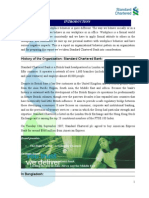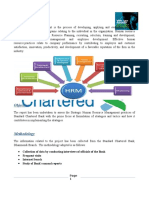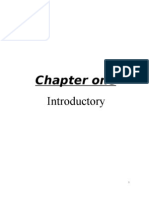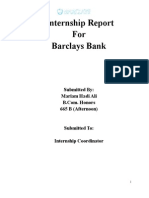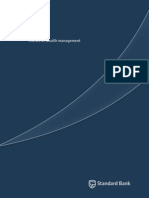Standard Chartered Bank Nepal MIS
Standard Chartered Bank Nepal MIS
Uploaded by
ManishDangolCopyright:
Available Formats
Standard Chartered Bank Nepal MIS
Standard Chartered Bank Nepal MIS
Uploaded by
ManishDangolOriginal Title
Copyright
Available Formats
Share this document
Did you find this document useful?
Is this content inappropriate?
Copyright:
Available Formats
Standard Chartered Bank Nepal MIS
Standard Chartered Bank Nepal MIS
Uploaded by
ManishDangolCopyright:
Available Formats
STANDARD CHARTERD BANK
STANDARD CHARTERD BANK
Contents
1
INTRODUCTION OF MIS ......................................................................................................................................1
INTRODUCTION OF STANDARD CHARTERED BANK ............................................................................................2
2.1
INTRODUCTION ............................................................................................................................................2
2.2
HISTORY OF STANDARD CHARTERED BANK .................................................................................................3
2.3
STANDARD CHARTERED BANK IN NEPAL: ....................................................................................................4
SERVICES OFFERED BY STANDARD CHARTERED BANK .......................................................................................6
3.1
CONSUMER BANKING ..................................................................................................................................6
3.2
WHOLESALE BANKING .................................................................................................................................7
3.3
SME BANKING ..............................................................................................................................................7
INFORMATION SYSTEM IN STANDARD CHARTERED ...........................................................................................8
DESCRIPTION OF DEPARTMENTS IN SCB ............................................................................................................9
5.1
BUSINESS INTELLIGENCE UNIT (BIU) ............................................................................................................9
5.2
LEGAL & COMPLIANCE .................................................................................................................................9
5.3
CREDIT AND COLLECTIONS .........................................................................................................................10
5.4
PHONE BANKING ........................................................................................................................................10
5.5
COMPLAINT MANAGEMENT ......................................................................................................................10
5.6
FINANCE DEPARTMENT ..............................................................................................................................10
IT DEPARTMENT IN STANDARD CHARTERED BANK ..........................................................................................11
HIERARCHY OF IT DEPARTMENT .......................................................................................................................12
7.1
DETAIL OF IT DEPARTMENT .......................................................................................................................12
7.2
EBBS (ELECTRONIC BASIC BANKING SYSTEM) ............................................................................................14
7.3
ECAP (ELECTRONIC CARD PROCESSING) ....................................................................................................15
7.4
SERVERS OF STANDARD CHARTED BANK ...................................................................................................15
7.5
SYSTEM NETWORK BANK ...........................................................................................................................16
DATA FLOW DIAGRAMS (DFD) ..........................................................................................................................18
8.1
CONTEXT DIAGRAM OF ATM MACHINE .....................................................................................................18
8.2
CONTEXT DIAGRAM LEVEL-0 OF ATM MACHINE .......................................................................................19
WEAKNESS IN EXISTING SYSTEM ......................................................................................................................20
10
SUGGESTIONS AND RECOMMENDATIONS .......................................................................................................20
11
CONCLUSION.....................................................................................................................................................20
STANDARD CHARTERD BANK
1 INTRODUCTION OF MIS
Information is the basis for every decision taken in an organization. The efficiency
of management depends upon the availability of regular and relevant information.
Thus it is essential that an effective and efficient reporting system be developed as
part of accounting system.
The main object of management information is to obtain the required information
about the operating results of an organization regularly in order to use them for
future planning and control. The old techniques like intuition, rule of thumb,
personal whim and prestige, etc. Are now considered useless in the process of
decision taking. Modern management is constantly on lookout for such quantitative
and such information, which can help in analyzing the proposed alternative actions
and choosing one as its decision.
Thus, modern management functions are information-oriented more popularly
known as management by information. And the system through which
information is communicated to the management is known as management
information system (MIS).
STANDARD CHARTERD BANK
2 INTRODUCTION OF STANDARD CHARTERED
BANK
2.1 INTRODUCTION
Standard Chartered has a history of over 150 years in banking and operates in
many of the world's fastest-growing markets with an extensive global network of
over 1,600 branches including subsidiaries, associates and joint ventures) in over
70 countries in the Asia Pacific Region, South Asia, the Middle East, Africa, the
United Kingdom and the Americas.
As one of the world's most international banks, Standard Chartered employs
70,000 people, representing over 125 nationalities, worldwide. This diversity lies
at the heart of the Bank's values and supports the Bank's growth as the world
increasingly becomes one market.
With strong organic growth supported by strategic alliances and acquisitions and
driven by its strengths in the balance and diversity of its business, products,
geography and people, Standard Chartered is well positioned in the emerging trade
corridors of Asia, Africa and the Middle East.
Standard Chartered derives over 90 per cent of profits from Asia, Africa and the
Middle East. Serving both Consumer and Wholesale Banking customers
worldwide, the Bank combines deep local knowledge with global capability to
offer a wide range of innovative products and services as well as award-winning
solutions.
Standard Chartered is also committed to all its stakeholders by living its values in
its approach towards managing its people, exceeding expectations of its customers,
making a difference in communities and working with regulators.
STANDARD CHARTERD BANK
2.2 HISTORY OF STANDARD CHARTERED BANK
Standard Chartered was formed in 1969 through a merger of two banks: The
Standard Bank of British South Africa, founded in 1863, and the Chartered Bank
of India, Australia and China, founded in 1853.
2.2.1 THE CHARTERED BANK:
The Chartered bank was founded by
James Wilson following the grant of a
Royal Charter by Queen Victoria in
1853. Chartered bank opened its first
branches in Mumbai (Bombay),
Kolkata and Shanghai in 1858,
followed by Hong Kong and Singapore
in 1859.
2.2.2 THE STANDARD BANK:
The Standard bank was founded in the
Cape Province of South Africa in 1862
by John Paterson. The bank
commenced business in Port Elizabeth,
in January 1863.
STANDARD CHARTERD BANK
2.3 STANDARD CHARTERED BANK IN NEPAL:
Standard Chartered Bank Nepal Limited has been in operation in Nepal since 1987
when it was initially registered as a joint-venture operation. Today the Bank is an
integral part of Standard Chartered Group having an ownership of 75% in the
company with 25% shares owned by the Nepalese public. The Bank enjoys the
status of the largest international bank currently operating in Nepal.
Standard Chartered has a history of over 150 years in banking and operates in
many of the world's fastest-growing markets with an extensive global network of
over 1700 branches (including subsidiaries, associates and joint ventures) in over
70 countries in the Asia Pacific Region, South Asia, the Middle East, Africa, the
United Kingdom and the Americas. As one of the world's most international banks,
Standard Chartered employs almost 87,000 people, representing over 115
nationalities, worldwide. This diversity lies at the heart of the Bank's values and
supports the Bank's growth as the world increasingly becomes one market.
With 15 points of representation, 23 ATMs across the country and with more than
450 local staff, Standard Chartered Bank Nepal Ltd. is in a position to serve its
clients and customers through an extensive domestic network. In addition, the
global network of Standard Chartered Group gives the Bank a unique opportunity
to provide truly international banking services in Nepal.
Standard Chartered Bank Nepal Limited offers a full range of banking products
and services to a wide range of clients and customers encompassing individuals,
mid-market local corporate, multinationals, large public sector companies,
government corporations, airlines, hotels as well as the DO segment comprising of
embassies, aid agencies, NGOs and INGOs.
The Bank has been the pioneer in introducing 'customer focused' products and
services in the country and aspires to continue to be a leader in introducing new
products in delivering superior services. It is the first Bank in Nepal that has
implemented the Anti-Money Laundering policy and applied the 'Know Your
Customer' procedure on all the customer accounts.
STANDARD CHARTERD BANK
Corporate Social Responsibility is an integral part of Standard Chartered's
ambition to become the world's best international bank and is the mainstay of the
Bank's values. The Bank believes in delivering shareholder value in a socially,
ethically an environmentally responsible manner. Standard Chartered throughout
its long history has played an active role in supporting those communities in which
its customers and staff live. It concentrates on projects that assist children,
particularly in the areas of health and education. Environmental projects are also
occasionally considered. It supports non-governmental organizations involving
charitable community activities The Group launched two major initiatives in 2003
under its 'Believing in Life' campaign- 'Living with HIV/AIDS' and 'Seeing is
Believing'.
STANDARD CHARTERD BANK
3 SERVICES OFFERED BY STANDARD
CHARTERED BANK
3.1 CONSUMER BANKING
Standard Charted provides services for
Mortgages
Credit Cards
Personal Loans
Auto Loans
Wealth Management products.
STANDARD CHARTERD BANK
In order to maximize customer convenience, they offer
24-hour Phone Banking
e-Statements
SMS Banking
ATM Cards and VISA Debit Cards
Online Banking
3.2 WHOLESALE BANKING
Wholesale banking provides
Transactional banking
Debt Capital Markets
Corporate Finance
Derivatives & Fx Options
Commodity Finance and deposit products.
Treasury
3.3 SME BANKING
Standard Chartered Small Medium Enterprise (SME) banking provides services for
Small to medium size companies to expand their enterprise.
Tijarat Accounts
Business Installment Loans
Industry Specific Solutions
STANDARD CHARTERD BANK
4 INFORMATION SYSTEM IN STANDARD
CHARTERED
As Standard Chartered started their business in Nepal in1987, so they are using
information system since the start of their business in Nepal, there were no PRE-IS
era of Standard Chartered bank in Nepal. With the help of information technology
Standard Chartered bank record the daily transactions that took place from all over
the Nepal into a centralized database in real time, which means there is no Batch
processing is taking place in Standard Charted all over the Nepal. Every bank
branch is an online branch, which is directly connected to the centralized server to
keep the data up to date to avoid any problems.
As Time is money, and due to IS standard chartered bank make thousands of
transactions per day. In fact, IS makes whole process much more quickly, simple
and reliable. Due to IS employees can easily connect with other branches,
customer service gets improved, online banking emerged and lot of others benefits.
Standard Chartered Online is an innovative Online Banking service that you can
tailor to suit your precise banking needs. It gives you convenient, round-the-clock
banking services ranging from day-to-day account transfer transactions to real-time
valuable financial information. Now you can manage your finances anytime,
anywhere.
STANDARD CHARTERD BANK
5 DESCRIPTION OF DEPARTMENTS IN SCB
5.1 BUSINESS INTELLIGENCE UNIT (BIU)
The business intelligence unit (BIU) department provides valuable information to
the bank regarding to the new products. BIU gives detailed analysis of any product
data provided by Information technology department.
5.2 LEGAL & COMPLIANCE
The legal and compliance department is playing a very important role in this
organization. The department is responsible for all the legal work of the bank.
They have to make sure whether everything is going according to the government
policies and whether or not the organization is following all the rules of STATE
BANK OF NEPAL.
STANDARD CHARTERD BANK
5.3 CREDIT AND COLLECTIONS
The department is very vital in its functionality. Thats the reason why Standard
Chartered pays so much importance to it. The department performs several
important functions for the organization.
Some of them are
Loans Sanction
Loans Recovery & Collection
5.4 PHONE BANKING
Another consumer banking department which is solely responsible for phone
banking issues and at the same time they have to make sure the user is having the
same level of personalized services that would expect in branches.
5.5 COMPLAINT MANAGEMENT
Complaint management department is responsible for complaints received from
customer via Phone, Email, Web and providing them support on timely manners.
5.6 FINANCE DEPARTMENT
The department is very vital in its functionality. Thats the reason why Standard
Chartered pays so much importance to it. The department performs several
important functions for the organization.
Some of them are
Financial Forecasting
Capital Budgeting
Credit Management
10
STANDARD CHARTERD BANK
6 IT DEPARTMENT IN STANDARD CHARTERED
BANK
As IT is playing a vital role in this organization, the bank has state of the art IT
infrastructure which is working 24/7 to ensure that everything is running smoothly
and the bank systems are not exposed to the outside world. IT Department itself is
a huge department in Standard Charted bank, having many sub departments under
its area. The IT department provides services, support to other departments as well
as also acting as a backbone of the Core banking system of Standard Chartered
Bank. In broader terms the IT department is in charge of
All Communications throughout the branches & data centers, which
Includes Voice, Data, Fax, Wireless mediums.
Monitoring the services of existing applications running inside the
organization.
Monitoring the services of existing applications running inside the
organization.
Monitoring of Critical applications, which need 99% uptime.
Providing service to on production applications
Networks and other connectivity mediums
Security of existing & new applications
Security of networks
In-house security issues
11
STANDARD CHARTERD BANK
7 HIERARCHY OF IT DEPARTMENT
7.1 DETAIL OF IT DEPARTMENT
7.1.1 NETWORKS & COMMUNICATIONS
The department is responsible for managing all the network and communication
that took place inside the bank which includes Internet, Intranet, Extranet, Voice,
Fax services. The core responsibilities of this department is
Managing existing data network.
Managing the voice network.
Managing the Fax network.
12
STANDARD CHARTERD BANK
7.1.2 SERVICE MANAGEMENT
The department is responsible for providing services to the new as well as existing
applications running inside the organization. The department is also responsible for
monitoring the application uptime and providing maximum uptime to the critical
applications to avoid any financial & service loss and assigning the privileges to
the employees.
7.1.3 SECURITY & RISK
The department is responsible for all the security issues that could happen in the
existing system which includes Internet Banking securities, network securities,
external & local access etc.
7.1.4 TECHNICAL SERVICES
The department is responsible for all the hardwares that are placed inside the
organization; they provide support and services to any kind of hardware issues
from a single desktop pc to their servers.
7.1.5 BANKING SUPPORT SOFTWARES
Standard Charted has more than 80 different business softwares running to fulfill
their business needs. Each software is specifically designed for a specific
department and intended to perform some specific task in order to help the bank
run their everyday business process effectively. Some softwares are crossfunctional helping different departments.
13
STANDARD CHARTERD BANK
7.2 EBBS (ELECTRONIC BASIC BANKING SYSTEM)
Core banking is the heart of any organization; Standard chartered core banking
application is EBBS (Electronic Basic Banking System) which is the actual
strength of this bank. EBBS is the single software suit that work on these basic
modules
Saving / Current Accounts
Customer Information System
New Accounts
Demand Deposits
Clearings
Time Deposits
Loans
Credit Lines
Automatic Transfers
Tax Information
Cashiers Checks
Construction Loans
Sensitive Accounts
Warnings
On-Line Transactions Authorizer
14
STANDARD CHARTERD BANK
7.3 ECAP (ELECTRONIC CARD PROCESSING)
Another core banking application that Standard Chartered is using is ECAP
(Electronic Card Processing System) which is used to manage all the Credit and
Debit Cards of the account holders.
The software has these two basic modules
Debit Card
Credit Card
7.4 SERVERS OF STANDARD CHARTED BANK
Standard Chartered has a centralized server machines running day and night to
ensure the maximum uptime and top-notch quality to their applications, which
dramatically support their whole business process. The bank servers resides in
different cities and data centers of Nepal i.e. Karachi, Lahore, Islamabad and all of
them are interconnected with each other for real time data update and
synchronization.
As a rule stated by Nepal Rastra Bank; A bank must have 3 years of customer
data in their servers. To abide this rule, Standard Chartered stores the last 3+
years of data into their local sever which are residing in Nepals data centers for
quick access of data and other issues.
The bank archives the old data to their Main Server in Chennai, India, which is the
main server for Middle East region. The Chennai servers holds the archived data
of all the Standard Chartered branches in Middle East region and when any branch
need to access the old data; they connect to the Chennai servers and download the
required data.
Standard Chartered is using IBM servers in Nepal. The configuration of server
depends upon the load of work it handles and the application, which is running on
the server. If the application is critical then the server is also of high configuration.
15
STANDARD CHARTERD BANK
7.5 SYSTEM NETWORK BANK
Networking is the milestone achieved by Standard Chartered bank, which gives the
integration between information systems of various departments. Standard
Chartered is using CISCO networks to maximize the outcome and to enhance the
communication quality within their organization, which results in the better
service. Standard Chartered has different types of network configuration for
different scenarios; some of them are discussed below.
7.5.1 LOCAL AREA NETWORK (LAN)
The local area network (LAN) is running inside the organization and providing
ultimate connectivity between the employees and other persons. There are some
Workgroup applications also running over their LAN for easy collaboration
between the employees of same and different departments. The LAN is not
exposed to the outside world for security reasons and there is a proxy server
running for connectivity outside the organization which makes sure the internal
network is not exposed to the internet.
16
STANDARD CHARTERD BANK
7.5.2 NETWORK BETWEEN DATA CENTERS
As Standard Chartered has different servers located at different areas of Nepal, so
the networking between them is necessary. Each data center is directly connected
to another data center using two links (i.e. Radio & Optical Fiber) because if one
link goes down, there is a second one to give backup link, If a wired is cut off then
the radio link is available for connectivity and if there is a frequency block in radio
link, there is a wired link to give backup to the network. Each branch has two links,
one is DXX which is connected to the nearest data center and another link is VSAT
which is connected to the second nearest data center to make sure branch keep
working if there is a problem occur in any one of the data centers.
17
STANDARD CHARTERD BANK
8 DATA FLOW DIAGRAMS (DFD)
8.1 CONTEXT DIAGRAM OF ATM MACHINE
18
STANDARD CHARTERD BANK
8.2 CONTEXT DIAGRAM LEVEL-0 OF ATM MACHINE
19
STANDARD CHARTERD BANK
9 WEAKNESS IN EXISTING SYSTEM
Standard Chartered existing information technology system is fulfilling all of their
need without any error, and the network terminologies they implemented is serving
excellent in terms of quality and security.
The weakness in their existing system is that they stores only the last 3 years of
customer data into their local server to follow the NEPAL RASTRA BANK law.
But in some cases they have to retrieve the old data from their Chennai, India
server, which cost them money for downloading as well as uploading.
10 SUGGESTIONS AND RECOMMENDATIONS
Standard Chartered bank should store all of the customer data into its local servers
for faster access to the old data and to save the money they spent in order to
download the archived data from the Chennai server.
11 CONCLUSION
This report is complete implementation of our course study. After our visit to
multinational organization, we came to know how these organization works in
order to maintain their standard and market share in the industry. We also came to
know the different industrial standards that an organization has to follow in order
become agile. This report helped us in clearly understanding the complex business
logics as well as the impact of short and long-term strategies.
The report also gives us practical exposure to some state of the art IT infrastructure
like redundant networks etc and their impact on day-to-day business. The project
helped us in developing interpersonal skills, awareness of work environment in
organization and the role of Information system in organizations.
20
You might also like
- OrcafAPI ManualDocument39 pagesOrcafAPI ManualgenmikNo ratings yet
- Standard CharteredDocument27 pagesStandard CharteredGulraiz Hamid100% (1)
- Royal Bank of CanadaDocument21 pagesRoyal Bank of CanadaPradeep Gautam100% (1)
- Standard Chartered BankDocument37 pagesStandard Chartered BankFiOna SalvatOre100% (1)
- Report SCBDocument3 pagesReport SCBmostaindu07No ratings yet
- Business and Organisation Structure of Standard Chartered BankDocument17 pagesBusiness and Organisation Structure of Standard Chartered BankHumaira Shafiq0% (1)
- Introduction of Standard Chartered Bank HistoryDocument12 pagesIntroduction of Standard Chartered Bank HistoryZunaira RizviNo ratings yet
- Standard Charted BankkDocument28 pagesStandard Charted BankkKomal SheikhNo ratings yet
- Standard Chartered BankDocument22 pagesStandard Chartered Bank12ekNo ratings yet
- Standard Chartered BBank Bangladesh.Document23 pagesStandard Chartered BBank Bangladesh.Suvir SahaNo ratings yet
- Chapter 2Document10 pagesChapter 2maherchowdhury91No ratings yet
- SCBLPDocument18 pagesSCBLPKamran Ali AbbasiNo ratings yet
- Final Project Report of SCBDocument32 pagesFinal Project Report of SCBseth_eshita087499100% (3)
- Standard Chartered BankDocument56 pagesStandard Chartered BankTarekNo ratings yet
- SCB Assignment by MGTDocument27 pagesSCB Assignment by MGTfarahNo ratings yet
- A Study On Attrition Rate in Standard Chartered Bank Jaat BudhiDocument78 pagesA Study On Attrition Rate in Standard Chartered Bank Jaat Budhikhrn_himanshuNo ratings yet
- Sales Promotion and Customer Awareness of The Services, Standerd Charterd Finance Ltd. by Shiv Gautam - MarketingDocument67 pagesSales Promotion and Customer Awareness of The Services, Standerd Charterd Finance Ltd. by Shiv Gautam - MarketingRishav Ch100% (1)
- Letter of Transmittal: Subject: Submission of Standard Chartered Bank Reports For The Course of Human ResourceDocument13 pagesLetter of Transmittal: Subject: Submission of Standard Chartered Bank Reports For The Course of Human Resourcetaseen rajNo ratings yet
- Project Report STANDARD CHARTERED BANKDocument51 pagesProject Report STANDARD CHARTERED BANKashishgarg100% (2)
- Standard Chartered Bank PakistanDocument19 pagesStandard Chartered Bank PakistanMuhammad Mubasher Rafique100% (1)
- Standard Chartered BankDocument17 pagesStandard Chartered BankShakil KhanNo ratings yet
- History: The Chartered BankDocument7 pagesHistory: The Chartered Bankketakm99No ratings yet
- Collection of Data by Conducting Interviews of Officials of The Bank Frequent Visits Internet Search Study of Bank's Annual ReportsDocument19 pagesCollection of Data by Conducting Interviews of Officials of The Bank Frequent Visits Internet Search Study of Bank's Annual ReportsFarjana Islam MouNo ratings yet
- Human Resource Management Report (2012)Document31 pagesHuman Resource Management Report (2012)Syed Abdul MateenNo ratings yet
- Assessment 1: Vikas Gurudev, ID NO: 11010560Document10 pagesAssessment 1: Vikas Gurudev, ID NO: 11010560Vikas GurudevNo ratings yet
- Standard Chartered Bank ShortcutDocument20 pagesStandard Chartered Bank ShortcutRoyNo ratings yet
- Standard Chartered BankDocument20 pagesStandard Chartered Bankjisansalehin1No ratings yet
- Standard Chartered GroupDocument9 pagesStandard Chartered GroupALI100% (1)
- Standard Chartered Bank of PakistanDocument29 pagesStandard Chartered Bank of PakistanMian Ali Raza RafiqNo ratings yet
- Ask For DowryDocument18 pagesAsk For DowryMuhammad AhmedNo ratings yet
- Exchange Exposure at Canara Bank Project ReportDocument110 pagesExchange Exposure at Canara Bank Project ReportBabasab Patil (Karrisatte)No ratings yet
- Acknowledgement: Miss - Deepa Nair (Exim Proffessor)Document25 pagesAcknowledgement: Miss - Deepa Nair (Exim Proffessor)Avani ShahNo ratings yet
- BD SC Bank Inaugurates New Gulshan North BranchDocument3 pagesBD SC Bank Inaugurates New Gulshan North BranchAkashNo ratings yet
- Mission, Vission & Swot Anaylysis of Standard Chartred BankDocument3 pagesMission, Vission & Swot Anaylysis of Standard Chartred BankFahad Khan TareenNo ratings yet
- Chapter One: IntroductoryDocument83 pagesChapter One: IntroductoryBaquie BillahNo ratings yet
- Standard Chartered Bank: Mangement Education and Research InstituteDocument114 pagesStandard Chartered Bank: Mangement Education and Research Institutevikas@davimNo ratings yet
- International Banks Updated Jun 8 2022 Lyst9086Document17 pagesInternational Banks Updated Jun 8 2022 Lyst9086HarshithaNo ratings yet
- Standard CharteredDocument3 pagesStandard CharteredPiyush NigamNo ratings yet
- A Report On Standard Chartered BankDocument56 pagesA Report On Standard Chartered BankRumana AhmadNo ratings yet
- Bank AlfahaDocument94 pagesBank AlfahamcbNo ratings yet
- Standard Chartered HR Intern Report BangladeshDocument65 pagesStandard Chartered HR Intern Report BangladeshNeeloy Hoque50% (4)
- Section 2 ReferencedDocument6 pagesSection 2 ReferencedAwesum Allen MukiNo ratings yet
- Standard Chartered Bank ProfileDocument8 pagesStandard Chartered Bank ProfileNeeloy HoqueNo ratings yet
- Standard Chartered Bank ManagementDocument17 pagesStandard Chartered Bank ManagementTejas KambleNo ratings yet
- Who Is HSBCDocument10 pagesWho Is HSBCNava NavaneethanpNo ratings yet
- Ntroduction: Ead Office Gulshan Avenue Gulshan DhakaDocument20 pagesNtroduction: Ead Office Gulshan Avenue Gulshan DhakaMd. Thasin Hassan Shifat 2031495630No ratings yet
- Executive SummaryDocument83 pagesExecutive Summarysimranarora2007No ratings yet
- EVALUATION OF MUTUAL FUND INDUSTRY (Akbar)Document61 pagesEVALUATION OF MUTUAL FUND INDUSTRY (Akbar)AKBARKHAN7777No ratings yet
- Financial Statement Analysis SCBDocument31 pagesFinancial Statement Analysis SCBShahada Sagor100% (1)
- Internship Report On Barclays PakistanDocument95 pagesInternship Report On Barclays Pakistanmariamhadi100% (2)
- Job Satisfaction of Employees: A Study On Standard Chartered BankDocument29 pagesJob Satisfaction of Employees: A Study On Standard Chartered BankStacy D'SouzaNo ratings yet
- History of Askari Commercial BankDocument176 pagesHistory of Askari Commercial BankKhalid Habib Ali KhanNo ratings yet
- Management Information System of Standard Charterd Bank PVT LTDDocument18 pagesManagement Information System of Standard Charterd Bank PVT LTDPakassignmentNo ratings yet
- Wealth Man BrochureDocument12 pagesWealth Man Brochuredipl0No ratings yet
- Assignment of MisDocument20 pagesAssignment of Mis8537814No ratings yet
- Accounting, Auditing and Governance for Takaful OperationsFrom EverandAccounting, Auditing and Governance for Takaful OperationsNo ratings yet
- Digital Financial Services in the Pacific: Experiences and Regulatory IssuesFrom EverandDigital Financial Services in the Pacific: Experiences and Regulatory IssuesNo ratings yet
- Banking 2020: Transform yourself in the new era of financial servicesFrom EverandBanking 2020: Transform yourself in the new era of financial servicesNo ratings yet
- Shari'ah Non-compliance Risk Management and Legal Documentations in Islamic FinanceFrom EverandShari'ah Non-compliance Risk Management and Legal Documentations in Islamic FinanceNo ratings yet
- Ill-Gotten Money and the Economy: Experiences from Malawi and NamibiaFrom EverandIll-Gotten Money and the Economy: Experiences from Malawi and NamibiaNo ratings yet
- AviationWeek 2014-09-01Document52 pagesAviationWeek 2014-09-01Adrian BistreanuNo ratings yet
- References 2 PDFDocument3 pagesReferences 2 PDFHanafiahHamzahNo ratings yet
- IEC 60364 - 5!53!2002 - Electrical Installation of BuildingsDocument78 pagesIEC 60364 - 5!53!2002 - Electrical Installation of BuildingsRebeca MancillaNo ratings yet
- Podaboli Kirtan Book (Lila Kirtan)Document32 pagesPodaboli Kirtan Book (Lila Kirtan)Krishna ShilNo ratings yet
- AI7697HD Product Brief - V02Document2 pagesAI7697HD Product Brief - V02Quốc ThịnhNo ratings yet
- Rotameters DatasheetDocument3 pagesRotameters Datasheetاحمد العبيديNo ratings yet
- Unit 1 PPT 2Document15 pagesUnit 1 PPT 2ece Ms.G.BhargaviNo ratings yet
- Ntnu 2012 PDFDocument315 pagesNtnu 2012 PDFArpanNo ratings yet
- Performance Analysis of Different 8-Bit Full AddersDocument5 pagesPerformance Analysis of Different 8-Bit Full AddersIOSRjournalNo ratings yet
- VoiceDocument3 pagesVoiceAshwani KumarNo ratings yet
- New Microsoft Word DocumentDocument9 pagesNew Microsoft Word DocumentHardeep69No ratings yet
- Verbal and Visual Support in PresentationsDocument21 pagesVerbal and Visual Support in Presentationsapi-253143542No ratings yet
- TBKT - SBul 177 Navigat 100-200 New Mod 10-4 ContainerDocument5 pagesTBKT - SBul 177 Navigat 100-200 New Mod 10-4 Containerhangdung19921991No ratings yet
- HPUX-Command N - ZDocument440 pagesHPUX-Command N - ZT.S.A.Zahir HussainNo ratings yet
- Chevron Espana S.A Appointment Letter 2011-1Document6 pagesChevron Espana S.A Appointment Letter 2011-1Abhik SarkarNo ratings yet
- IBM Cognos - Business InteligenceDocument593 pagesIBM Cognos - Business InteligenceKata TothNo ratings yet
- Proposed 2-Storey, 3 Bedroom Residential Location: Brgy. Daungan, Hermosa, BataanDocument12 pagesProposed 2-Storey, 3 Bedroom Residential Location: Brgy. Daungan, Hermosa, BataanRalph Abe Alipio Dominguez100% (1)
- The Problem and Its BackgroundDocument7 pagesThe Problem and Its BackgroundJb SantosNo ratings yet
- U.S. Coast Guard Oral History Program - EM2 Rodney GordonDocument8 pagesU.S. Coast Guard Oral History Program - EM2 Rodney GordonM. Darryl WoodsNo ratings yet
- How To Install Wine On Ubuntu 16.04Document32 pagesHow To Install Wine On Ubuntu 16.04didierNo ratings yet
- Waste Management - Jasleen Arora - IIFT DelhiDocument10 pagesWaste Management - Jasleen Arora - IIFT DelhisudhirnairNo ratings yet
- Chapter 1Document21 pagesChapter 1ruby_shaNo ratings yet
- PCR Machine PachageDocument9 pagesPCR Machine PachagelinubinoiNo ratings yet
- Love Sabah PartyDocument1 pageLove Sabah PartytompidukNo ratings yet
- Pump MAWP CalculationDocument6 pagesPump MAWP CalculationSantosh0% (1)
- Microsoft Visio 2013 OverviewDocument22 pagesMicrosoft Visio 2013 OverviewGot Da Blunt0% (1)
- Frauscher - MsdacDocument90 pagesFrauscher - Msdacser.aman1992No ratings yet
- Manual de InstalareDocument6 pagesManual de InstalarePaul PopescuNo ratings yet
- Rfi & HPR Form - 12e-C01-Ce-0042 - FDT & Surveyor Inspection For 3rd Layer Backfilling Prior ToDocument4 pagesRfi & HPR Form - 12e-C01-Ce-0042 - FDT & Surveyor Inspection For 3rd Layer Backfilling Prior ToSarah AzizNo ratings yet




